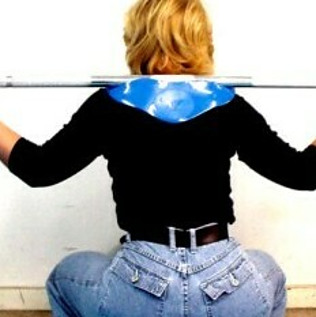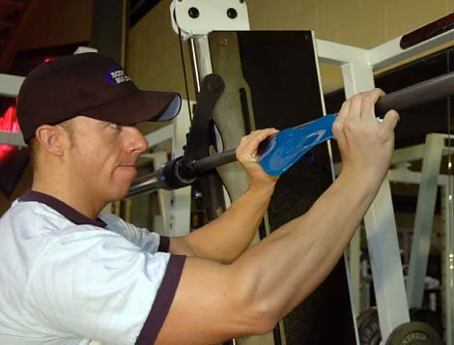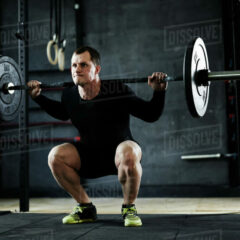https://weightliftingforpower.com/Using-Manta-Ray-For-Squats/exercise-for-strength/admin/

Understanding Manta-Ray Squats: Enhancing Your Lower Body Workouts
Improved Comfort and Safety:
One of the primary advantages of Manta Ray squats is the enhanced comfort they provide during the exercise. The Manta Ray device sits on the upper back, creating a cushioned surface that evenly distributes the weight. It alleviates pressure on the shoulders and reduces the risk of discomfort or injury with traditional barbell squats. By improving comfort and safety, Manta Ray squats allow individuals to focus on proper form and technique, leading to more effective workouts.
Targeted Muscle Activation:
Manta Ray squats also target specific muscles more effectively than traditional squats. The device’s design shifts the load to the hips and glutes, allowing for greater activation of these muscle groups. This targeted activation can improve strength gains in the lower body, particularly in the quadriceps, hamstrings, and gluteal muscles. By engaging these muscles more efficiently, Manta Ray squats can help individuals overcome plateaus and achieve new levels of strength.
Increased Range of Motion:
Another benefit of Manta Ray squats is the potential for an increased range of motion. The device’s unique design allows for a deeper squat position, enabling individuals to engage their muscles through a more excellent range of motion.
The Ergonomic Design of the Manta Ray:
The Manta Ray stands out with its lightweight and durable design that fits securely on the upper back, just below the neck. Its unique shape and contouring provide a comfortable fit, reducing pressure points and discomfort. The Manta Ray’s ergonomic design ensures even weight distribution across the shoulders, minimizing stress on the spine and joints.
The Manta Ray’s raised barbell support pads are a critical feature that sets it apart. These pads elevate the barbell slightly above the shoulders, creating a more natural position for the lifter’s hands. This innovative design alleviates strain on the wrists and elbows, enabling a more comfortable grip during squats.
Furthermore, the Manta Ray’s curved shape promotes proper spinal alignment. Cradling the barbell and guiding it along the upper back’s natural curvature encourages a more upright posture. This alignment is crucial for engaging the correct muscle groups and avoiding unnecessary strain on the lower back.
Improved Squatting Form:
By using the Manta Ray, lifters can achieve better squatting form, leading to improved performance and reduced risk of injury. This equipment’s ergonomic design helps address common issues that can arise during squats.
Firstly, the Manta Ray promotes a more upright torso position. It is crucial for engaging the quadriceps, glutes, and hamstrings effectively. By maintaining an upright chest and straight back, lifters can ensure proper load distribution and muscle targeting.
Secondly, the Manta Ray’s raised barbell support pads encourage a wider grip. This wider grip allows for excellent stability and control during the squat movement. It also helps to activate the upper back muscles, promoting better overall posture.
The Benefits of Manta Ray Squats
Manta Ray squats offer several advantages over traditional squats. Firstly, the Manta Ray apparatus, a padded barbell attachment, helps distribute the weight more evenly across your upper back, reducing strain on the shoulders and neck. It allows for a more comfortable and stable squatting position, enabling you to focus on proper form and technique.
Furthermore, Manta Ray squats engage the core muscles more than regular squats. The added challenge of stabilizing the weight on your upper back forces your core muscles to work harder, leading to improved core strength and stability. This increased core engagement enhances your squat performance and improves overall athletic performance.
Additionally, Manta Ray squats target the upper back muscles, including the traps and rhomboids. Holding the barbell across your upper back activates these muscles to maintain proper posture throughout the movement. Strengthening these muscles improves your squat form, helps alleviate postural imbalances, and reduces the risk of upper back injuries.
Performing Manta-Ray Squats
To perform Manta-Ray squats correctly:
Place the padded barbell attachment on your upper back, below the base of your neck.
Ensure that the barbell is centered and secure on your back.
During the exercise, stand with your feet shoulder-width apart, toes slightly turned out, and keep your back straight.
As you lower your body, hinge your hips back and bend your knees, keeping them aligned with your toes. Aim to lower yourself until your thighs parallel the ground or slightly below. To return to the starting position, engage your core and drive through your heels. Remember to breathe steadily throughout the movement and maintain proper form.
Mastering the Technique: Step-by-Step Guide to Manta Ray Squats
Stance:
Proper stance is crucial for maintaining balance and stability when performing Manta-Ray squats. “Start by positioning yourself with your feet at a shoulder-width distance from each other.”A wider stance helps engage the glutes and hamstrings more effectively. Experiment with different foot angles to find your body’s most comfortable and natural position.
Bar Positioning:
“The Manta Ray pad is designed to improve comfort and stability while performing squats.” To correctly position the bar, place the Manta Ray pad on your upper back, just below the base of your neck. The pad should rest comfortably on your traps, providing a cushioned surface for the barbell.
With the pad adequately positioned, the next step is to carefully place the barbell on top of the Manta Ray pad. The barbell should be centered and balanced, with equal weight on both sides. It is essential to position the bar correctly to ensure proper form and maximum effectiveness of the exercise. Take the time to adjust the bar position until it feels secure and comfortable.
Incorrect Bar Placement
Among the most common errors when doing Manta-Ray bows is putting the bar too high or too low on the back. Wrong bar placement can result in discomfort and stress in the neck, shoulders, and reduced back. To prevent these problems, place the Manta Ray device on the top back, just below the neck’s base. This positioning permits a more stable and comfy placement throughout the exercise.
2. Incorrect Foot Positioning
An additional risk to keep an eye out for is incorrect foot placing. Placing the feet close or far apart can compromise balance and security during the squat. Position your feet shoulder-width apart to maintain the appropriate type, with toes slightly directed externally. This position aids in dispersing weight uniformly and involves reduced body muscles more effectively.
3. Inadequate Depth
Several people tend to perform shallow squats, not getting to an adequate deepness. When doing squats, you have to make sure you go reduced enough. It would help if you turned on the targeted muscles effectively, and the workout will be as effective—to squat up until your thighs are identical or a little, as listed below.
A prevalent error during Manta-Ray squats is overlooking the core muscular tissues. A stable core is crucial for maintaining proper form while executing this exercise. To trigger your core, concentrate on tightening your stomach muscles and keeping your back neutral. It will undoubtedly improve your efficiency and lessen the opportunity of experiencing reduced back injuries.

https://www.wealthyaffiliate.com?a_aid=352a86b2
